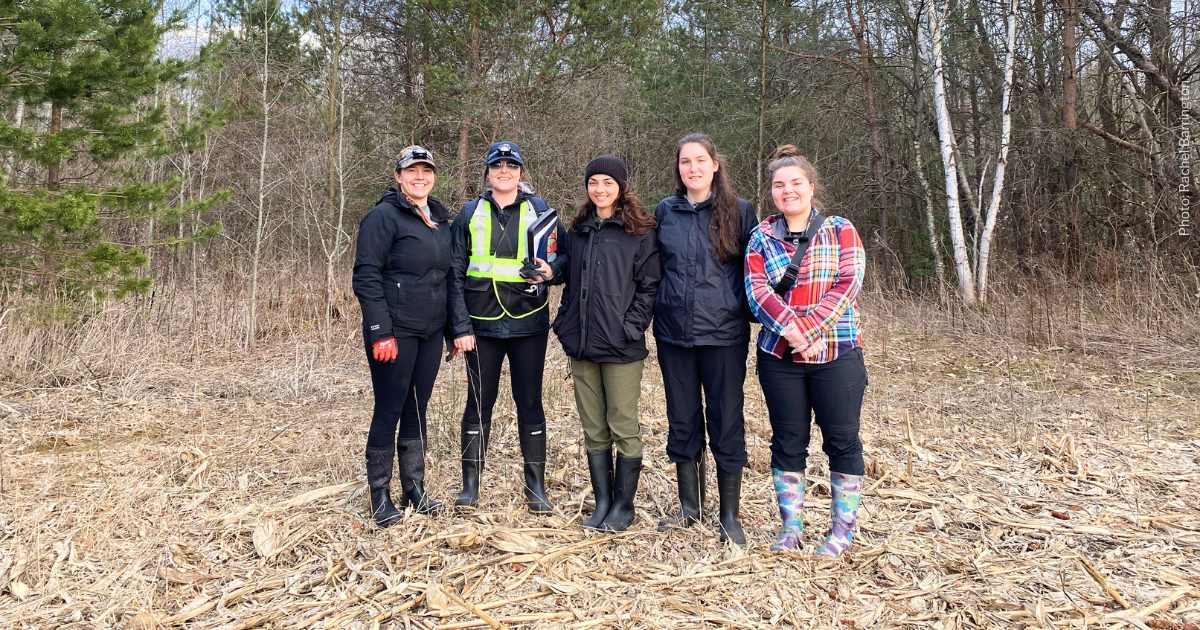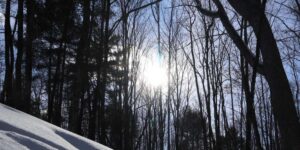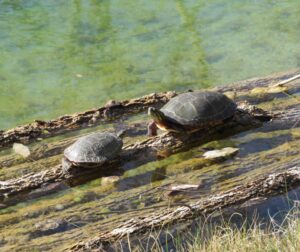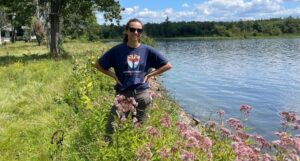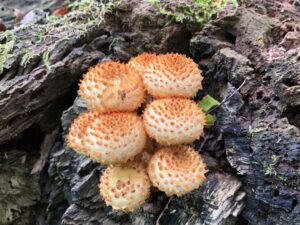By Samantha Coppola, Fleming College student and KLT volunteer
As another winter season came to an end, so began the collaborative efforts of Kawartha Land Trust’s (KLT) Rachel Barrington, Partners in Conservation (PIC) Coordinator, volunteers, and landowners enrolled in KLT’s Partners in Conservation program to explore their lands and take an uncovered look (literally) at the landscape in search of salamanders throughout the Kawarthas.
As a sensitive species with absorbent skin, salamanders are excellent indicators of healthy ecosites and are an important part of a functioning ecosystem. They are also a very fun and cute surprise for many when flipping logs and rocks in the woods. It is important to collect population data for sensitive species that live in developed areas to further understand their habitat limitations within changing environments at larger scales, as well as consider the favourable habitat conditions on smaller-scale ecosites, such as the properties we investigated that have different land-use histories.
This year, I and fellow student Ryleigh Poulet Ramage and KLT staff led eager KLT volunteers through the various locations included in our Salamander Survey Project as part of our field placement for the Ecosystem Management Technician program at Fleming College.
Dividing our efforts, Ryleigh focused on the Lindsay area, while I supported the surveys closer to Peterborough. Rachel Barrington started this project last year as a way of connecting private landowners enrolled in KLT’s Partners in Conservation program to the ecology of their respective properties through hands-on learning about salamanders, while also contributing to valuable data collection and hands-on fieldwork.
While following the protocol crafted by Trent University student Jordan McDonald, we were surveying at dusk for four species: Eastern Red-backed Salamanders, Spotted Salamanders, Blue-Spotted Salamanders, and Four-Toed Salamanders.
Volunteers of all ages participated, as well as the landowners themselves, to aid in the search for these somewhat elusive amphibians. Together, we discussed the best locations and conditions to find salamanders, safe handling and put-back practices, and used listening skills to identify other species around us such as the Western Chorus Frog, Barred Owl, Wilson’s Snipe, and American Woodcock. It was unquestionable that the star of the show this year was the Eastern Red-backed Salamander with 28 individuals recorded on one property alone!
In salamanders’ breeding season, which is early spring, Spotted Salamanders congregate in vernal pools and shallow marshes to lay eggs with other amphibians like Spring Peepers and Wood Frogs, of which we heard many throughout the surveys. A few volunteers even witnessed frog eggs including Spring Peeper and Wood Frog egg masses laid in a cattail marsh, sparking discussions on the difference between salamander and frog eggs.
With help, Ryleigh and I surveyed 12 properties, fostering a heartwarming atmosphere amongst other nature enthusiasts, including kids, who were more than happy to throw on a pair of tall rubber boots, trek through shallow water and thickets, and revel in the many sounds that arise in the forest once the sun goes down.
The landowners who came out gained insights into salamander habitats and volunteers were a great help in the search, making it a fun and very memorable experience. We all agreed that surveying at night was an exciting and unique chance to see and hear many other species like bats and insects that would otherwise be missed.
I met so many wonderful people through participating in this project, all with varying skill levels in biology and ecology. I’m extremely grateful to have expanded my knowledge and connected with new people on deeper levels through shared passions for nature, community, and of course, salamanders.
“Thanks to KLT’s wonderful Partners in Conservation, placement students from Fleming College, and our team of “Sallie Squad” volunteers, we were able to deliver this survey program for a second year,” said Rachel Barrington, KLT’s Partners in Conservation Coordinator
“Because of their efforts, we were able to collect important information on local amphibian populations, which are sensitive to human impacts and need to be studied in the context of how these creatures use habitats on working landscapes. Oftentimes the scientific community is driven to research species at risk, but it’s also important to consider species that are not (at least presently) considered to be at risk so that we have records of their populations to note positive or negative changes. Salamander surveying is a great way for amateur and expert naturalists alike to connect to nature – they are relatively easy to search for, slow-moving, and generally cooperative for photo ops! We had a wonderful time and I’m grateful to student volunteers like Samantha Coppola and Ryleigh Poulet Ramage for their contributions to amphibian research in our region.”
You can learn more about Kawartha Land Trust’s Partners in Conservation program on our website.
Main photo: One group of KLT volunteers ready for an evening of surveying for salamanders in the Kawarthas.

